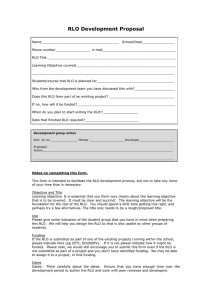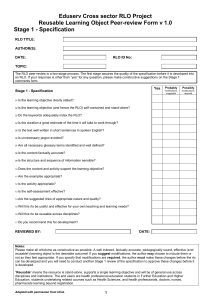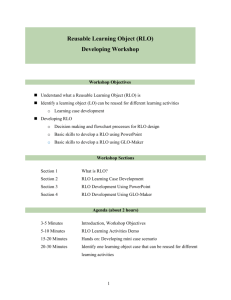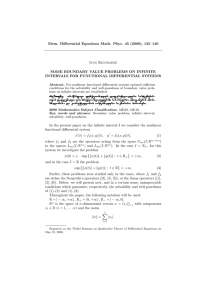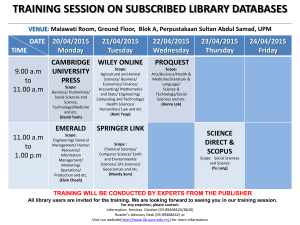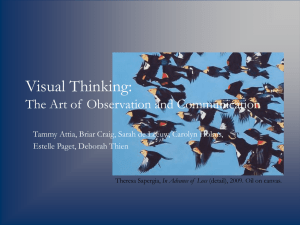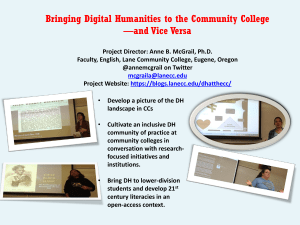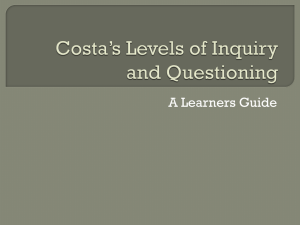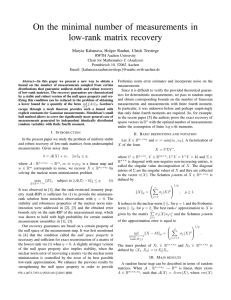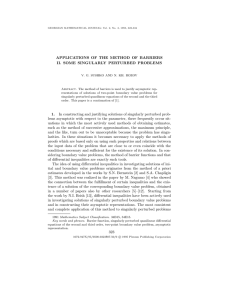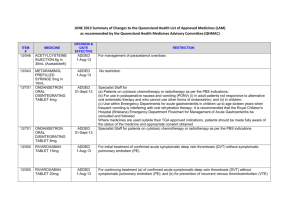Presentation
advertisement
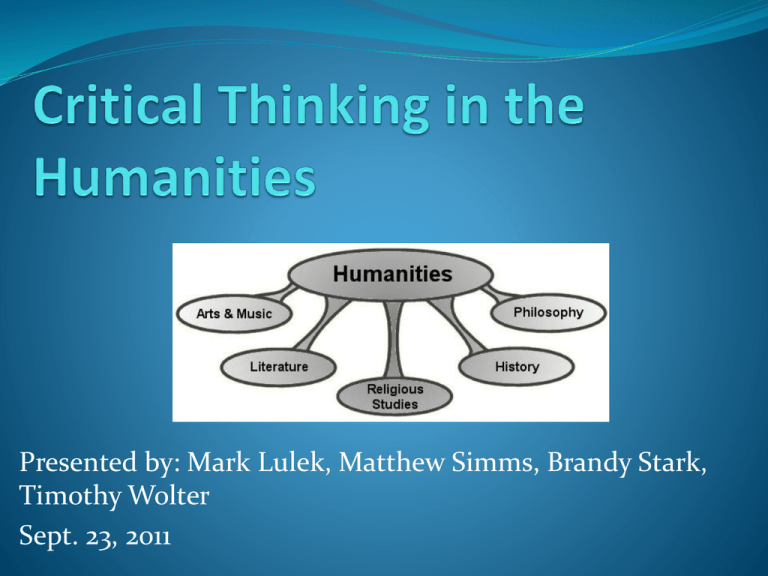
Presented by: Mark Lulek, Matthew Simms, Brandy Stark, Timothy Wolter Sept. 23, 2011 Critical Thinking Definition of Critical Thinking for SPC: CRITICAL THINKING is the active and systematic process of *Communication *Problem-solving *Evaluation *Analysis *Synthesis *Reflection both individually and in community to *Foster understanding *Support sound decision-making and *Guide action. Goal Goal: To try and contribute to Humanities faculty meaningful ways to implement critical thinking activities in classroom presentations. Project Project: To create a reusable scenario for HUM 2210 that others can make use of, learn from, and adopt into classroom presentations. Ideally, this should be suitable (with some format modifications) for face to face, blended, and online courses. What is a RLO? RLO: Reuseable Learning Objective Small multimedia/electronic segments, components, modules or mini-lessons that can be developed, used and reused in numerous courses (Project Eagle Statement of Work, 2003). They can be designed to have considerable interactivity and alternate paths (as in gaming and simulations), hence providing a potential for promoting critical thinking. "Simulations create a complete environment within which students can apply theory to and practice skills in real-world issues related to their discipline. They motivate students, provide opportunities for active participation, promote deep learning, develop interactive and communication skills, and link knowledge and theory to application" (Hertel & Millis, 2002, book jacket). What is an RLO? The idea behind the project is to create a template that is flexible. It promotes critical thinking and can be transformed as needed from one class to the next. Process Brief Description of Process: As required in Humanities classes, students must participate in an out of class cultural activity. Preferred activities include events hosted at the SPC Music Center, Palladium Theatre, Crossroads Gallery, and Clearwater Fine Arts Auditorium (as applicable). This RLO/intervention provides structure for student response. Process Class discussion on project and objectives. Students download RLO/intervention from ANGEL. Students visit museum/interactive location. Students respond to the proposed questions to create a reflection paper. Students post and/or discuss their reflections with class. Humanities RLO/Intervention (First Discussion) Communication: Introduction Class discussion: What are the functions of art? Define and discuss them. Explain why you think that these are the most important functions of art. •Presentation of discussion without PowerPoint? •Discussion Humanities RLO/Intervention (Activity and Research Paper) Students should focus on answering the following components: Analysis: Comparison/Contrast Experience/direct contact analysis. Find at least two works of art [insert further restrictions here; pre- and post- Impressionism, two cultures, etc.] that you belief most fulfill the functions of art. Describe them. Consider their function, techniques the artist uses, the purpose or intention or attitude of the artist, the setting, the patron, etc. Humanities RLO/Intervention (Research Paper) Selection and Solution: Identify which of your chosen works of art you like best. Explain what attracts you. Be sure to maintain a focus on the functions of art you identified in your introduction. Humanities RLO/Intervention (Research Paper) Evaluation What are the strengths and attractions of the other work of art? Who might prefer it? Why so? Does it fulfill different functions, or fulfill them in different ways? Humanities RLO/Intervention (Research Paper) Synthesis Discuss any universal elements or ideas that you find in the art. Or, discuss why this theme seems of interest in both the past and the present. You could also include a discussion of how the function might have changed, even though the theme has remained constant. RLO/Intervention (Concluding Discussion) Reflection Class Discussion: What have you discovered about yourself, your values, your attitudes and tastes, while you were exploring these art works? Class discussion, can be informal, subjective, reflective. Some may utilize the discussion forums (ANGEL) to continue this project outside of class. An HUM 2233 Writing Project based on the same Rubric This is an In-Class Writing. You can bring any resources you like to class for the writing. You have to write the piece starting from blank paper, during class. You can use notes, rough drafts, etc.. If you quote sources, reference. Please don’t play with plagiarism; I recognize it readily, I can check it easily, and plagiarism will earn a zero on the assignment. Although research is not required for this assignment, you can research if you like, but write in your own words.. Organization, grammar and spelling are definitely grade issues. Ideas and insight, clean prose and solid organization, rather than mere word count, are the keys. You need to include copies of the art works you are writing about. These are the sections the paper needs to contain. You need to label each section in your paper. I. Communication: Introduction Select several functions of art from the list we generated. Define them, discuss them. Explain why you think these are the (most) important functions of art. II. Analysis: Comparison/Contrast Choose or create a topic. Find (at least) two works of art that express that topic. One must be pre-impressionism; one must be post-impressionism. Compare/contrast the works of art. Describe them. Consider their function, the techniques the artist uses, the purpose or intention or attitude of the artist, the setting, the patron, etc. III. Selection and Solution Identify which of your chosen works of art you like best. Explain what attracts you. Be sure to maintain a focus on the functions of art you identified in your introduction. IV. Evaluation What are the strengths and attractions of the other work of art? Who might prefer it? Why so? Does it fulfill different functions, or fulfill them in different ways? V. Synthesis Discuss any universal elements or ideas that you find in the art. Or, discuss why this theme seems of interest in both the past and the present. You could also include a discussion of how the function might have changed. even though the theme has remained constant. VI. Reflection What have you discovered about yourself, your values, your attitudes and tastes, while you were exploring these art works? I.Communication: Introduction Select several functions of art. Define them, discuss them. Explain why you think these are the (most) important functions of art. Functions of Art Art is elusive, but a Work of Art is a vision of human reality – emotion, idea, values, religion, politics – expressed in medium and shared with others. Functions of Art (not mutually exclusive) Stimulation of thought or feeling Ritual Political and Social Comment Therapy Artifact/History Commodity Entertainment Teaching I.Communication:Introduction Generally, a Work of Arts offers a vision of some aspect of human reality. The art is expressed through a medium and shared with an audience. The most important function of art is its ability to express and stimulate thoughts and feelings. Some art works clearly seem more intellectual – like abstraction – and some more deliberately invoke an emotional response, like romanticism or expressionism. Personally, I often cannot distinguish clearly between those two responses; art that I’m drawn to usually makes me both think and feel. The historical function of art particularly interests me as well. Art is the only avenue through which the past can be accesses on its own terms. The audience has to take the time to look and listen carefully, but something of the values and texture of the distant past remains in the images, the carvings, the buildings, the writings, and the musical expressions that the people crafted. Student Discussion How will this improve our students’ ability to think critically? Peer input Other ideas/projects Comments? Additional Resources RLO: http://www.spcollege.edu/criticalthinking/resources/r lo.htm More on critical thinking for SPC: http://www.spcollege.edu/criticalthinking/professiona ls/teaching.htm Examples of portfolios (2011 is not included because it is not completed): https://angel.spcollege.edu/section/default.asp?id=Ins tPort%5FQEP%5F0400

